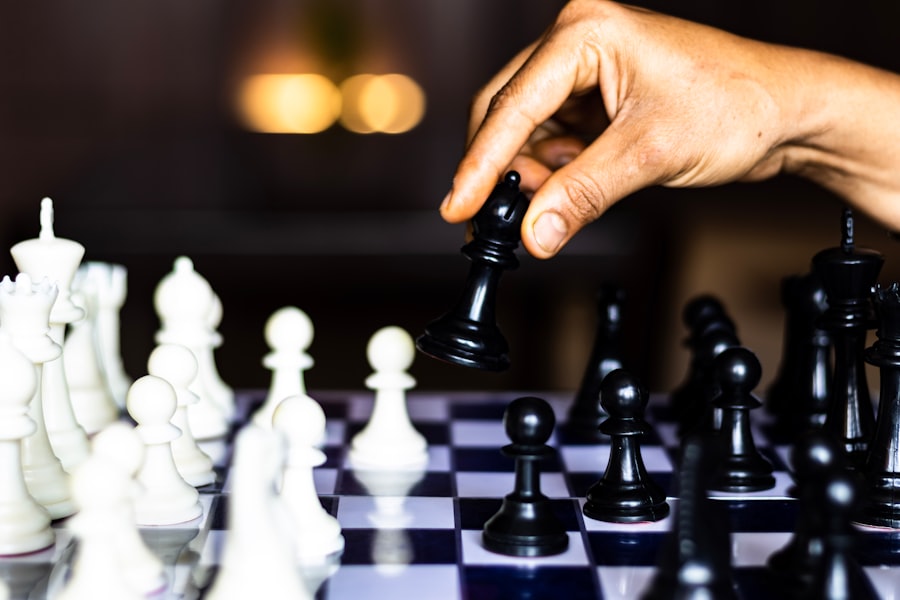Download links
How to install Mastering Chess: Strategies for Success APK?
1. Tap the downloaded Mastering Chess: Strategies for Success APK file.
2. Touch install.
3. Follow the steps on the screen.
Description
Chess is a two-player strategy board game that has captivated minds for centuries. The game is played on an 8×8 grid, known as a chessboard, where each player begins with 16 pieces: one king, one queen, two rooks, two knights, two bishops, and eight pawns. Each piece has its own unique movement rules, which contribute to the complexity and depth of the game.
The objective is to checkmate the opponent’s king, meaning the king is in a position to be captured and cannot escape. This fundamental goal drives all strategies and tactics employed throughout the game. The pieces are not only defined by their movement but also by their relative value.
For instance, pawns are generally considered the least valuable, worth one point each, while the queen is the most powerful piece on the board, valued at nine points. Understanding these values helps players make informed decisions about exchanges and sacrifices during play. Additionally, players must grasp concepts such as control of the center, piece development, and king safety.
These foundational principles form the bedrock of effective chess play and are essential for both beginners and advanced players alike.
Key Takeaways
- Understanding the basics of chess is crucial for beginners, including learning the movement of each piece and the objective of the game.
- Developing a strong opening repertoire involves studying and practicing various opening moves to gain an early advantage in the game.
- Mastering tactical and positional play requires understanding different strategies and tactics to control the board and create favorable positions.
- Improving endgame techniques involves learning how to convert an advantage into a win and understanding key endgame principles.
- Enhancing strategic thinking and planning involves analyzing the position, formulating long-term plans, and making strategic decisions based on the position of the pieces.
- Tips for improving your chess skills include practicing regularly, analyzing your games, learning from stronger players, and staying updated on the latest chess developments.
Developing a Strong Opening Repertoire
Understanding Opening Systems
Players should familiarize themselves with various opening systems, such as the Ruy Lopez, Sicilian Defense, and Queen’s Gambit, among others. Each opening has its own strategic ideas and typical pawn structures that can lead to different types of positions. By studying these openings, players can develop a deeper understanding of the resulting middlegame positions.
Comprehending Strategic Principles
example, in the Ruy Lopez, White aims to control the center while developing pieces harmoniously. Understanding why certain moves are played allows players to adapt their strategies when faced with unexpected responses from their opponents.
Selecting Openings that Fit Your Style
Additionally, players should consider their personal style when selecting openings; aggressive players may prefer sharp lines in the Sicilian Defense, while more positional players might gravitate towards the solid structures of the Queen’s Gambit Declined.
Mastering Tactical and Positional Play

Tactics and positional play are two fundamental aspects of chess that every player must master to achieve success. Tactical play involves short-term calculations and combinations that can lead to immediate advantages, such as winning material or delivering checkmate. Common tactical motifs include forks, pins, skewers, and discovered attacks.
Regular practice through puzzles and tactical exercises can sharpen a player’s ability to recognize these patterns quickly during a game. On the other hand, positional play focuses on long-term strategic considerations. It involves evaluating piece placement, pawn structure, and control of key squares or files.
A player skilled in positional play understands how to create weaknesses in their opponent’s position while strengthening their own. For instance, controlling open files with rooks or placing knights on strong outposts can lead to significant advantages over time. Balancing tactical awareness with positional understanding is crucial; a player who excels in tactics but neglects positional considerations may find themselves in trouble against a more strategically minded opponent.
Improving Endgame Techniques
| Technique | Description | Benefits |
|---|---|---|
| King and Pawn Endgames | Focuses on using the king to support the advancement of pawns in the endgame | Improves understanding of pawn promotion and endgame strategy |
| Rook Endgames | Teaches how to use rooks effectively in the endgame, including the concept of the “Lucena position” | Enhances ability to convert advantages into wins in rook endgames |
| Bishop and Knight Endgames | Explores the unique challenges and strategies of endgames with bishops and knights | Develops proficiency in handling complex endgames with minor pieces |
| Opposite-Color Bishop Endgames | Examines the dynamics of endgames with bishops of opposite colors | Enhances understanding of drawing chances and winning possibilities in such endgames |
The endgame is often where many games are decided, yet it is frequently overlooked by players who focus primarily on openings and middlegame tactics. An understanding of endgame principles can turn a drawn position into a win or save a lost position from defeat.
Players should study fundamental endgame positions such as king and pawn versus king, basic checkmates (like king and queen versus king), and common pawn structures. One effective way to improve endgame skills is through practical exercises that involve playing out various endgame scenarios against a computer or a training partner. This hands-on approach allows players to internalize key techniques such as opposition and triangulation.
Additionally, studying classic endgame literature can provide insights into famous games and techniques used by grandmasters. For example, understanding how Anatoly Karpov utilized pawn structure in his endgames can offer valuable lessons on converting slight advantages into victories.
Enhancing Strategic Thinking and Planning
Strategic thinking in chess involves formulating long-term plans based on an assessment of the position on the board. This requires not only an understanding of one’s own pieces but also an awareness of the opponent’s potential threats and weaknesses. Players should learn to evaluate positions critically by considering factors such as piece activity, pawn structure, king safety, and control of key squares.
Developing a habit of asking questions about the position—such as “What are my opponent’s threats?” or “How can I improve my worst-placed piece?”—can foster deeper strategic insights. Planning is an integral part of strategic thinking; it involves setting specific goals for piece placement or pawn breaks that align with the overall strategy. For instance, if a player has a strong knight on an outpost but lacks control over open files, they might plan to double rooks on a file where they can exert pressure on their opponent’s position.
Additionally, players should be flexible in their planning; as the game evolves, new opportunities may arise that require adjustments to previously established plans. This adaptability is key to navigating complex positions effectively.
Tips for Improving Your Chess Skills

Utilizing Analysis Tools
Utilizing chess software or online platforms that provide analysis tools can enhance this process by highlighting blunders and suggesting alternative moves.
Engaging with the Chess Community
Another valuable tip is to engage with the chess community through clubs or online forums. Discussing games with fellow enthusiasts can provide fresh perspectives and insights that may not have been considered otherwise.
Setting Goals and Participating in Tournaments
Participating in tournaments—whether online or over-the-board—can also expose players to diverse styles and strategies, further enriching their understanding of the game. Lastly, setting specific goals for improvement—such as mastering a particular opening or achieving a certain rating—can provide motivation and direction in one’s chess journey. Incorporating these strategies into regular practice will not only enhance technical skills but also foster a deeper appreciation for the intricacies of chess as a timeless intellectual pursuit.
If you’re a fan of chess, you may also be interested in learning about the benefits of playing chess online. According to a study mentioned in this article, playing chess online can improve cognitive skills, memory, and problem-solving abilities. So, next time you’re looking for a mental workout, consider challenging yourself with a game of online chess.
FAQs
What is chess?
Chess is a two-player strategy board game that is played on an 8×8 grid. It is one of the most popular and enduring games in the world, with a rich history dating back over a thousand years.
How is chess played?
Chess is played on a square board divided into 64 squares, with each player starting with 16 pieces: one king, one queen, two rooks, two knights, two bishops, and eight pawns. The objective of the game is to checkmate the opponent’s king, which means putting the king into a position where it cannot escape capture.
What are the basic rules of chess?
Each type of chess piece moves in a specific way, and players take turns moving their pieces across the board. The game ends when one player’s king is in checkmate, or when a stalemate is reached.
What are the benefits of playing chess?
Chess has been shown to have numerous cognitive benefits, including improving memory, concentration, problem-solving skills, and strategic thinking. It is also a great way to improve patience and decision-making abilities.
What is the history of chess?
Chess originated in India around the 6th century and spread to Persia, where it became known as “shatranj.” It then spread to Europe and evolved into the game we know today. Chess has a rich and storied history, with many famous players and iconic matches throughout the centuries.
Are there different variations of chess?
Yes, there are many different variations of chess, including speed chess (blitz and bullet), chess960 (also known as Fischer Random Chess), and team chess (such as bughouse or team relay chess). Each variation has its own unique rules and strategies.





